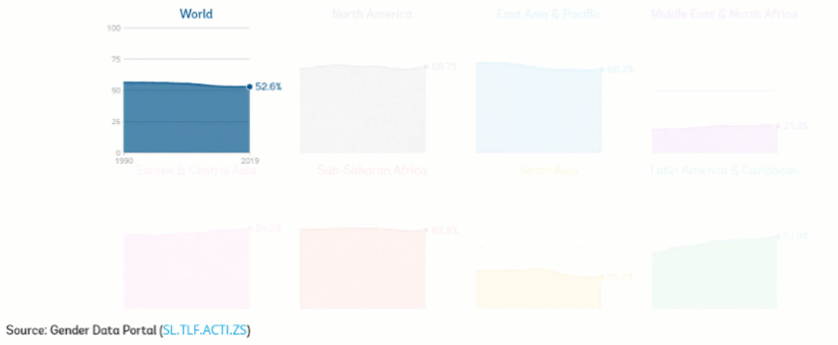Today, on International Women’s Day, we delve into data from the World Bank’s Gender Data Portal to explore some of the obstacles still preventing women from fully participating in the economy and explain how gender data can help overcome them. As we work towards gender equality and economic recovery globally, gender data are critical to inform policymaking and adapt interventions and services to those who need it most.
Scroll through our data story below to learn more.
Fact 1: Globally, nearly one in three women have experienced violence.
Violence against women and girls is a global pandemic. Almost one in three—or 736 million—women above the age of 15 across the world have experienced intimate partner violence or non-partner sexual violence at least once in their lifetime. More than one in four women have suffered violence at the hands of their partners (as you can explore in the graph below).
When women are exposed to violence, the social and economic costs are significant. Data on gender-based violence are essential to understand the prevalence of the problem and its root causes, as well as to enable successful, evidence-based interventions.
Learn more about the latest estimates on violence against women and girls, and what to do about it in this data story.
Fact 2: The gap in labor force participation rate between women and men has not narrowed in most regions over the last three decades.
Globally, roughly half of working age women participate in the labor force, which is significantly lower than the male labor force participation rate of around 80%. This gap is virtually unchanged from what it was three decades ago. And there are sizeable differences in the level of female labor force participation across regions (as shown in the below chart).

Moreover, women tend to face inferior income opportunities and on average earn less than men.
We need gender-disaggregated data to fully understand these important gender inequalities in economic opportunities and provide an evidence base for gender-sensitive policy design.
Explore more aspects of female labor force participation through this data story.
Fact 3: Across the world, more than one in five women have been child brides.
According to the latest statistics (see below), more than one in five women were first married before the age of 18, with the practice of child marriage being most prevalent in Sub-Saharan Africa and South Asia.
Beyond being a human rights violation, child marriage also greatly undermines women’s and girls’ economic opportunities. It limits child brides’ access to education, reduces their future earnings, jeopardizes their health, and puts them at a heightened risk of domestic violence.
Data on the economic impacts of child marriage provide the foundation for advocacy campaigns to end the practice.
For more on the economic impacts of marriage, including child marriage, read this blog post.
Gender data like the above are a form of women’s and girls’ empowerment. They can help us understand the most pressing challenges and guide us to development policies and interventions to increase women’s participation in the economy and accelerate gender equality.
Continuing to invest in sex-disaggregated data collection efforts by National Statistics Offices (NSOs) through initiatives such as the World Bank’s Strengthening Gender Statistics project is key to keeping track of progress—or lack thereof—on women’s social and economic outcomes.



Join the Conversation